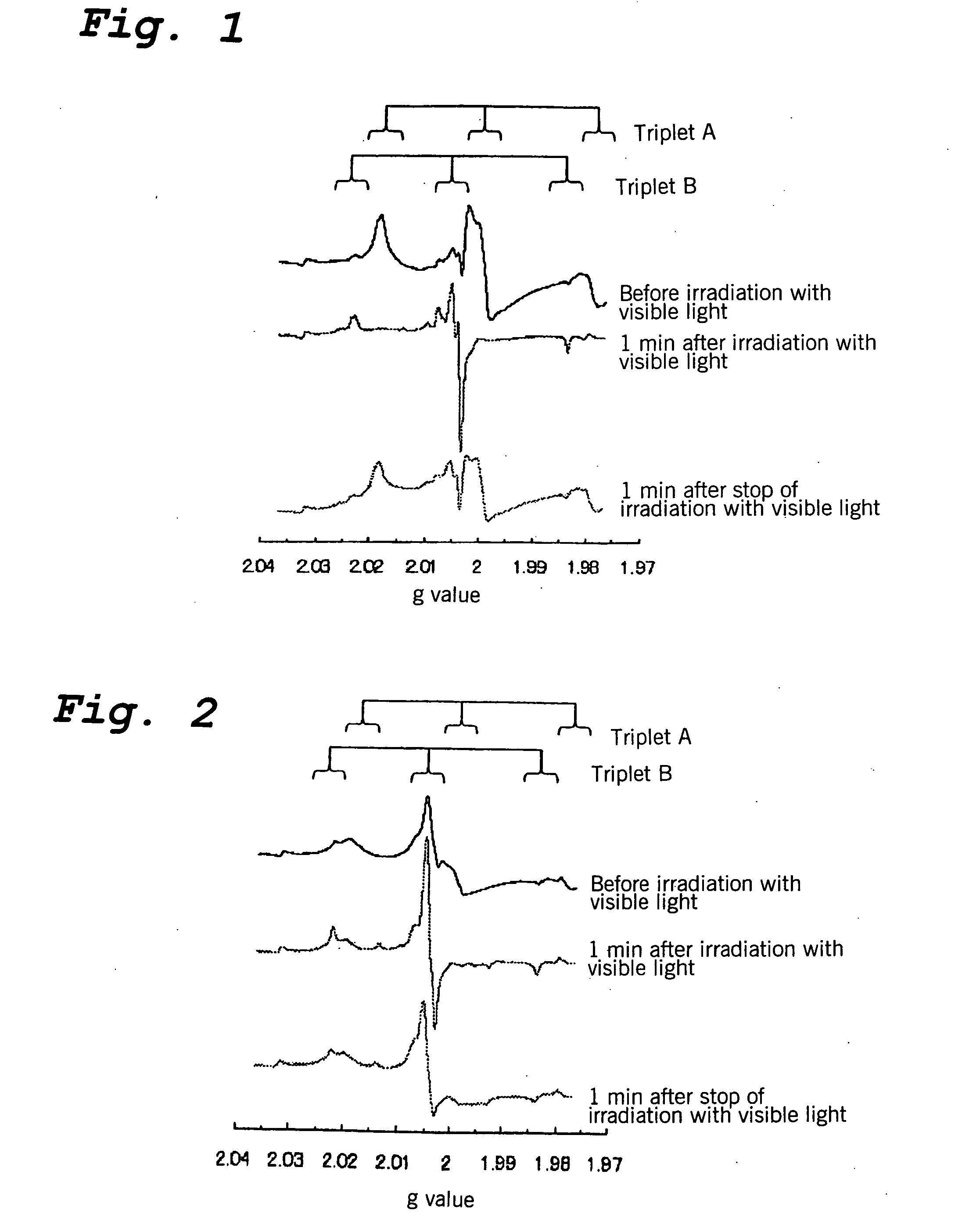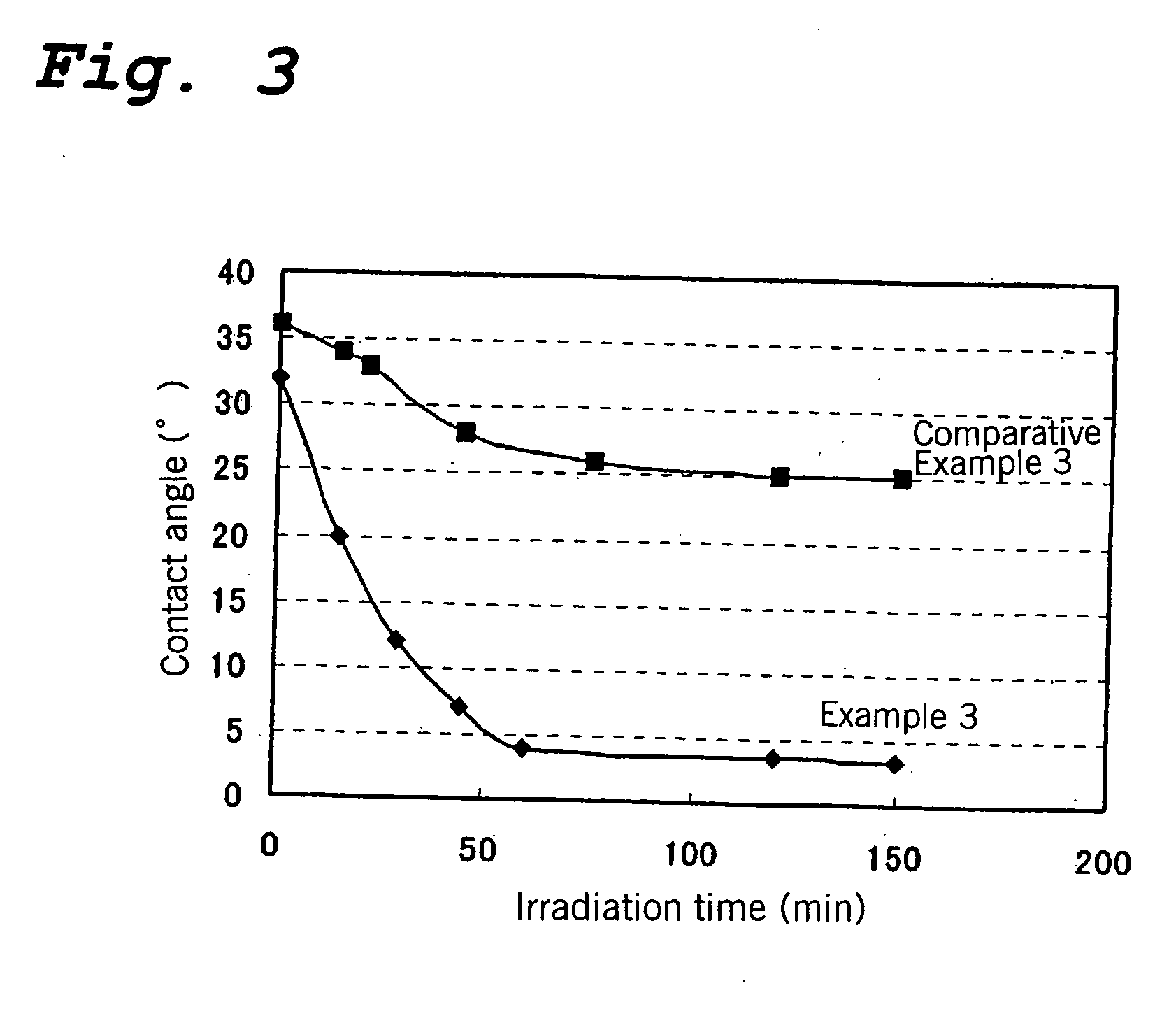Titanium Oxide Base Photocatalyst, Process for Producing the Same and Use Thereof
a titanium oxide and photocatalyst technology, applied in the direction of catalyst activation/preparation, metal/metal-oxide/metal-hydroxide catalyst, physical/chemical process catalyst, etc., can solve the problem of reducing the photocatalytic activity or reducing the photocatalytic activity itself, and the ability to decompose substances is inadequate, etc. problems, to achieve the effect of high photocatalytic activity and relatively inexpensive supply
- Summary
- Abstract
- Description
- Claims
- Application Information
AI Technical Summary
Benefits of technology
Problems solved by technology
Method used
Image
Examples
example 1
[Preparation of a Titanium Oxide Photocatalyst]
[0104] Aqueous ammonia (28%) was added dropwise to an aqueous TiCl4 solution (Ti concentration of 8.25%) with stirring at room temperature until the pH reached 4.8. The solids which were precipitated were collected by filtration, and after thorough washing with water, they were dried in vacuo at 80° C. to obtain a titanium (hydr)oxide powder for use as a raw material.
[0105] 200 grams of the resulting raw material powder were placed into a kiln-type heat treatment apparatus, and after the atmosphere in the apparatus was replaced with nitrogen, the temperature was increased to 315° C. Thereafter, a hydrogen gas containing 1.4 volume percent of TiCl4 as a hydrolyzable compound was introduced into the apparatus and was brought into contact with the raw material powder for 20 minutes to carry out a first step of heat treatment, thereby causing the titanium chloride to bond to the surface of the powder. Then, the atmosphere of the apparatus...
example 2
[Preparation of a Titanium Oxide Photocatalyst]
[0133] Aqueous ammonia (28%) was added dropwise to an aqueous TiCl4 solution (Ti concentration of 8.25%) with stirring at room temperature until the pH reached 4.8. The solids which were precipitated were collected by filtration, and after being thoroughly washed with water, they were vacuum dried at 80° C. to obtain a titanium (hydr)oxide powder for use as a raw material.
[0134] 200 grams of the resulting raw material powder were placed into a kiln-type heat treatment apparatus, and after the interior of the apparatus was replaced with argon gas, it was heated to 315° C. Thereafter, a hydrogen gas containing 1.4 volume percent of TiCl4 as a hydrolyzable compound was introduced into the apparatus and was brought into contact with the raw material powder for 20 minutes to perform a first stage of heat treatment, thereby causing the titanium chloride to bond to the surface of the powder. Then, the interior of the apparatus was again repl...
example 3
[0142] No. 1
[0143] Aqueous ammonia (28%) was added dropwise to an aqueous TiCl4 solution (Ti concentration of 8.25%) with stirring at room temperature until the pH reached 4.1. After this reaction mixture was allowed to stand for 10 days at room temperature to age the resulting precipitates, the solids were collected by filtration, then thoroughly washed with water, and dried in vacuo at 80° C. to obtain a titanium (hydr)oxide powder for use as a raw material.
[0144] 200 grams of the resulting raw material powder were placed into a kiln-type heat treatment apparatus, the interior of the apparatus was replaced by argon, and its temperature was raised to 315° C. Then, hydrogen gas containing 1.4 volume percent of TiCl4 as a hydrolyzable compound was introduced into the apparatus and was brought into contact with the raw material powder for 20 minutes to carry out a first stage of heat treatment and bond titanium chloride groups to the surface of the powder. Subsequently, the interior...
PUM
| Property | Measurement | Unit |
|---|---|---|
| Temperature | aaaaa | aaaaa |
| Temperature | aaaaa | aaaaa |
| Percent by mass | aaaaa | aaaaa |
Abstract
Description
Claims
Application Information
 Login to View More
Login to View More - R&D
- Intellectual Property
- Life Sciences
- Materials
- Tech Scout
- Unparalleled Data Quality
- Higher Quality Content
- 60% Fewer Hallucinations
Browse by: Latest US Patents, China's latest patents, Technical Efficacy Thesaurus, Application Domain, Technology Topic, Popular Technical Reports.
© 2025 PatSnap. All rights reserved.Legal|Privacy policy|Modern Slavery Act Transparency Statement|Sitemap|About US| Contact US: help@patsnap.com


